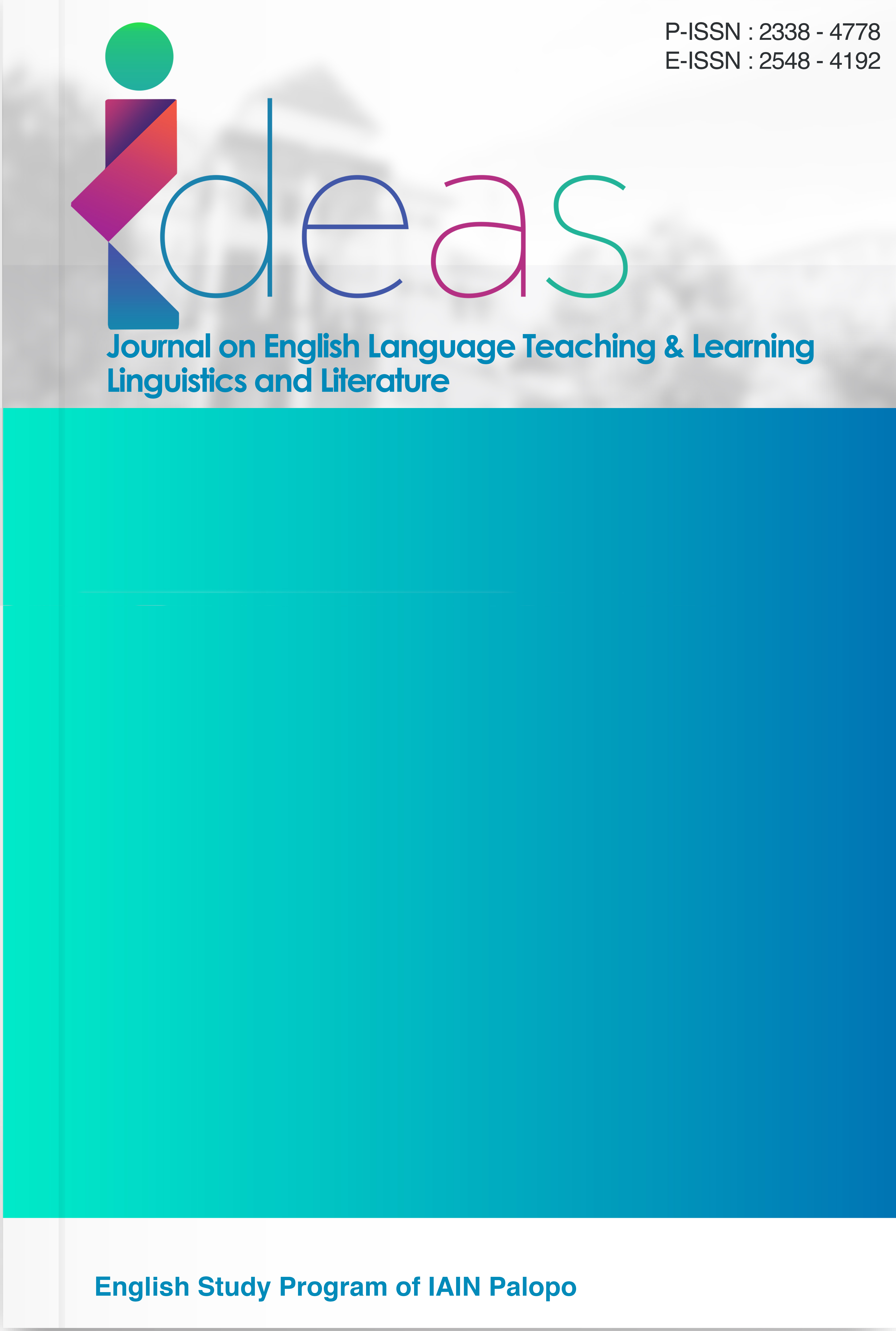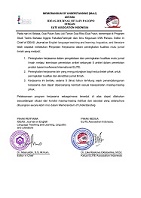Language Styles and Learning Motivation Changes in Instagram Captions: A Case of Three International Students
DOI:
https://doi.org/10.24256/ideas.v13i2.7728Keywords:
Instagram captions, language style, learning motivation, L2 Motivational Self System, transnational studentsAbstract
This study analyzes the changes in language style and English learning motivation reflected in 181 Instagram captions from three international students pursuing higher education in Indonesia. The analysis is based on Martin Joos's theory of language styles and Dörnyei's L2 Motivational Self System. This qualitative descriptive research focuses on comparing captions from the period before and during their study in Indonesia. The findings indicate a significant shift. Prior to their studies, the dominant language style was casual (41.41%), and motivation was rarely expressed (2.02%), categorized primarily as L2 Learning Experience. However, during their time abroad, language styles became more varied. While the casual style remained dominant (39.23%), the use of the consultative style also increased (23.20%), suggesting an adaptation to audience and communicative goals. Motivational expressions also increased significantly, especially L2 Learning Experience (19.34%), followed by Ideal L2 Self (6.08%) and Ought-to L2 Self (2.21%). These changes highlight the strong influence of social, academic, and personal development on language use and motivational expression on social media. The findings support Dörnyei's assertion that language motivation is not static but evolves in response to a learner's experiences. This research contributes to the literature on digital discourse and language learning motivation in the context of English education.
References
Al-Hoorie, A. H. (2018). The L2 motivational self-system: A meta-analysis. Language Learning, 68(3), 615–650. https://doi.org/10.1111/lang.12220
Bangun, M. A., Nasution, M. F. A., Sinaga, N. R., Sastra, S. F. D., & Khairani, W. (2024). Analisis pengaruh media sosial terhadap perkembangan bahasa Indonesia di era globalisasi. Jurnal Bahasa Daerah Indonesia, 1(3), 1–9. https://doi.org/10.47134/jbdi.v1i3.2646
Campus France. (2023, October). 430,466 foreign students in France in 2023–2024 [Press release]. Campus France.
Çömlekçi, M. F. (2020). Social media use among international students: Cultural adaptation and socialization. CELE Journal, 6, 668–685.
Creswell, J. W. (2012). Educational research: Planning, conducting, and evaluating quantitative and qualitative research (4th ed.). Pearson Education.
Dörnyei, Z. (2009). The L2 motivational self-system. In Z. Dörnyei & E. Ushioda (Eds.), Motivation, language identity and the L2 self (pp. 9–42). Multilingual Matters.
Dörnyei, Z., & Ushioda, E. (2011). Teaching and researching motivation (2nd ed.). Routledge.
Ebadi, S., Zandi, M., & Ajabshir, Z. F. (2024). The effect of language learning engagement on L2 motivation over Instagram. Acta Psychologica, 250, 104512. https://doi.org/10.1016/j.actpsy.2023.104512
Fitriati, S. W., & Rata, E. (2020). Language, globalisation, and national identity: A study of English-medium policy and practice in Indonesia. Journal of Language, Identity & Education, 20(6), 411–424. https://doi.org/10.1080/15348458.2020.1777865
García, O., & Wei, L. (2014). Translanguaging: Language, bilingualism and education. Palgrave Macmillan. https://doi.org/10.1057/9781137385765
Gee, J. P. (2011). How to do discourse analysis: A toolkit. Routledge. https://doi.org/10.4324/9781315819662
Henry, A. (2015). The dynamics of possible selves. In Z. Dörnyei, P. D. MacIntyre, & A. Henry (Eds.), Motivational dynamics in language learning (pp. 83–94). Multilingual Matters. https://doi.org/10.21832/9781783092574-011
Husnaini, H. (2022). Development of Self Esteem-Oriented Micro Teaching Materials for IAIN Palopo English Education Students. IDEAS: Journal on English Language Teaching and Learning, Linguistics and Literature, 10(1), 538-560.
Higgins, E. T. (1987). Self-discrepancy: A theory relating self and affect. Psychological Review, 94(3), 319–340. https://doi.org/10.1037/0033-295X.94.3.319
Ismayanti, D., & Syam, A. T. (2022). The Community Manipulation through Big Brother’ s Tyranny in George Orwell’ s Nineteen Eighty-Four. IDEAS: Journal on English Language Teaching and Learning, Linguistics and Literature, 10(2), 1556â-1569.
Jannah, L., Saragih, R. B. R., Perdana, D. D., & Putra, D. E. (2023). Penggunaan Instagram sebagai media promosi comedy event di Kota Bengkulu. Sibatik Journal: Jurnal Ilmiah Bidang Sosial, Ekonomi, Budaya, Teknologi, dan Pendidikan, 2(10), 3221–3228. https://doi.org/10.54443/sibatik.v2i10.1411
Joos, M. (1967). The five clocks: A linguistic excursion into the five styles of English usage. Harcourt Brace World Inc. https://openlibrary.org/books/OL32993557M/The_five_clocks
Juditha, C. (2019). Agenda setting penyebaran hoaks di media sosial. Jurnal Penelitian Komunikasi. https://jpk.kominfo.go.id/index.php/jpk/article/view/669
Kim, Y. Y. (2001). Becoming intercultural: An integrative theory of communication and cross-cultural adaptation. Sage Publications.
Kozinets, R. V. (2015). Netnography: Redefined. Sage Publications. https://books.google.com
Lang, J., Xiao, F., & Zhang, M. (2024). Second language motivational selves and interactional pragmatics in study abroad: A qualitative study. Languages, 9(12), Article 382. https://doi.org/10.3390/languages9120382
Lee, J. S. (2019). Digital communication, social media, and Englishes. World Englishes, 39(1), 2–6. https://doi.org/10.1111/weng.12447
Leong, P. (2015). Coming to America: Assessing the patterns of acculturation, friendship formation, and the academic experiences of international students at a U.S. college. Journal of International Students, 5(4), 459–474. https://doi.org/10.32674/jis.v5i4.408
Lin, J.-H., Peng, W., Kim, M., Kim, S. Y., & LaRose, R. (2012). Social networking and adjustments among international students. New Media & Society, 14(3), 421–440. https://doi.org/10.1177/1461444811418627
Munter, J., Calvo, B., Dino Morales, L. I., & Oroz, A. A. (2018). Service-learning field experiences to build intercultural competence: Teaching and learning on the U.S.–México border. In Handbook of research on service-learning initiatives in teacher education programs (pp. xx–xx). IGI Global.
OECD. (2015). International student mobility. OECD. Retrieved August 20, 2025, from https://www.oecd.org/en/data/indicators/international-student-mobility.html
Padgett, E. R., & Curwood, J. S. (2016). A figment of their imagination: Adolescent poetic literacy in an online affinity space. Journal of Adolescent & Adult Literacy, 59(4), 397–407. https://doi.org/10.1002/jaal.453
Seargeant, P., & Tagg, C. (Eds.). (2014). The language of social media: Identity and community on the Internet (pp. 112–136). Palgrave Macmillan. https://doi.org/10.1057/9781137029317
Shalihah, I., Handayani, L., & Fikri, S. (2024). Bahasa dalam strata sosial dan pemikiran representasinya pada pembelajaran bahasa Arab. Bahtera: Jurnal Pendidikan Bahasa dan Sastra, 23(1), 62–73. https://doi.org/10.21009/bahtera.231.05
Sibtiyah, S., & Latief, M. J. (2023). Analisis faktor yang mempengaruhi pebisnis menggunakan media sosial Instagram sebagai sarana promosi. Jurnal EMT Kita. https://doi.org/10.35870/emt.v7i1.752
Taguchi, T., Magid, M., & Papi, M. (2009). The L2 motivational self-system among Japanese, Chinese, and Iranian learners of English: A comparative study. In Z. Dörnyei & E. Ushioda (Eds.), Motivation, language identity and the L2 self (pp. 66–97). Multilingual Matters.
Thompson, A. S., & Vásquez, C. (2015). Exploring motivational profiles through language learning narratives. The Modern Language Journal, 99(1), 158–174. https://doi.org/10.1111/modl.12187
UNESCO Institute for Statistics. (2016). UNESCO Institute for Statistics (UIS). Retrieved August 20, 2025, from https://uis.unesco.org/
United Nations Educational, Scientific and Cultural Organization. (2024, February 20). Indonesian students studying abroad: 59,224 people.
Wu, Y. (2024). L2 motivational self-system and foreign language enjoyment as predictors of motivated behavior. Acta Psychologica, 251, 104585. https://doi.org/10.1016/j.actpsy.2023.104585
Zulfikar, I., & Digdowiseiso, K. (2023). The use of social media as a means of digital literacy: A literature study. International Journal of Economics, Management, Business and Social Science (IJEMBIS), 3(2), 399–409. https://cvodis.com/ijembis/index.php/ijembis/article/view/235
Downloads
Published
Issue
Section
Citation Check
License
Copyright (c) 2025 Vidya Mukti Cakraningrum, Widhiyanto

This work is licensed under a Creative Commons Attribution-ShareAlike 4.0 International License.
Authors retain copyright and grant the journal right of first publication with the work simultaneously licensed under an Attribution-ShareAlike 4.0 International (CC BY-SA 4.0) that allows others to share the work with an acknowledgement of the work's authorship and initial publication in this journal.
Authors are able to enter into separate, additional contractual arrangements for the non-exclusive distribution of the journal's published version of the work (e.g., post it to an institutional repository or publish it in a book), with an acknowledgement of its initial publication in this journal.
Authors are permitted and encouraged to post their work online (e.g., in institutional repositories or on their website) prior to and during the submission process, as it can lead to productive exchanges, as well as earlier and greater citation of published work (See the Effect of Open Access)




